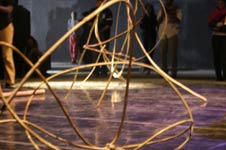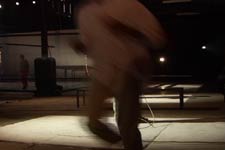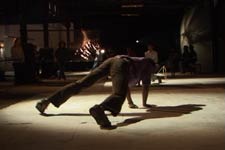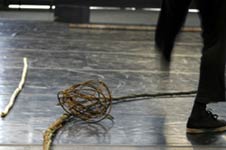     |
With support from : Afrique en Créations – Afaa, Association Française d’Action Artistique – Ministère des Affaires Etrangères, The Godown Art Centre - Nairobi, L’Alliance Française de Nairobi, L’Animal l’esquena, Spain “why stick to one when there are 360° possible” Zaha Hadid Limoges Honours Dance by Ayoko Mensah Africultures - published 24/11/05 translated from French Resolutely experimental 'shift...centre' is situated at the crossroads of dance and performance. Based on improvisation and instant composition this piece interrogates double relations: between 'space & perception' & between 'perception & identity'. Two questions that guide the choreographic research of Opiyo Okach for a number of years. Pluri-dimentionnality of space In his previous creation 'Abila' (2002) he investigates through video projection the pluri-dimentionnality of space and identity. This time the Choreographer goes further. Through subtle scenographic device - thanks to the talented Jean-Christophe Lanquetin - who partitions the space with translucent and mobile screens, the approach is more radical. 'Shift Centre' unravels the habitual conventions of representation: no stage-auditorium frontiers, no line of demarcation susceptible to distinguish performers from audience, no notification of beginning or end. Instead the audience is invited to saunter freely within the immense empty hall where the five performers are scattered (four men and a woman). |
|||||||||||||||||
'Interrogate the idea of space, call into question modes of spatial presentation where there is only one way to see, only one place of truth, is at the heart of the process of Shift', confirms the choreographer. 'How do we allow things to be perceived from different points of view and avoid formating them? To see only in one way is a tyranny of perception imposed by dominant conventions of presentation. This formats not just the public but the artist as well into a way of creating and perceiving.' Improvisation Political dimension For several years, Okach has artistically
affirmed a double credo: that of reality and multiple identity and its
corollary: a certain cultural relativism called tolerance. In Africa
we are in a position of being constantly exposed to a multiplicity of
realities and ways of being, he explains. ‘We live daily with
tradition, Islam, Christianity, MTV... it is normal to speak four languages.
( ... ) The artistic director of Gaaraprojects has always taken care to explore this richness of cultural mix. With successive pieces he unveils different facets of his identity: kenyan, european, urban, connections to people of his origin - the luo, this last piece does not escape the principle. As much by the origins of the artists gathered as by the diversity of artistic field (danse, music, song, video, sculpture). Okach telescopes the borders with pleasure. In Limoges one of the strongest moments is incidentally the presence of an elderly traditional kenyan singer. Ogoya Nengo. Wearing in a long woven dress of unbleached cotton and bearing a broad collar of artisan pearls she brings herself slowly cross the space while singing; arriving within the proximity of a dancer the later modifies their gesture to the point of adopting the sketch of a step into perfect harmony. Fragile encounter, sprout of an identity at sleep. ‘Le centre of the world is not just in one place. The centre is not where we are. It is fragmented. It implies to accept reality as multiple phenomenon , always in shift, we can only experience a selection of fragments at a time, recalls the choreographer. Today global trends affirm the dominance of one centre; that there is only one way to see. The danger of a place that that believes to hold the truth, to determine what is right or wrong.’ ‘why limit ourselves to one when there are 360 degrees possible.’ asks Okach citing the architect Zaha Hadid. His dance is the image of this question. It has nothing didactic, demonstrative or spectacular. Guided by instant, fluid and flexible exploration of space, up as down, reflection of breath more than certainty of result.
|
||||||||||||||||||